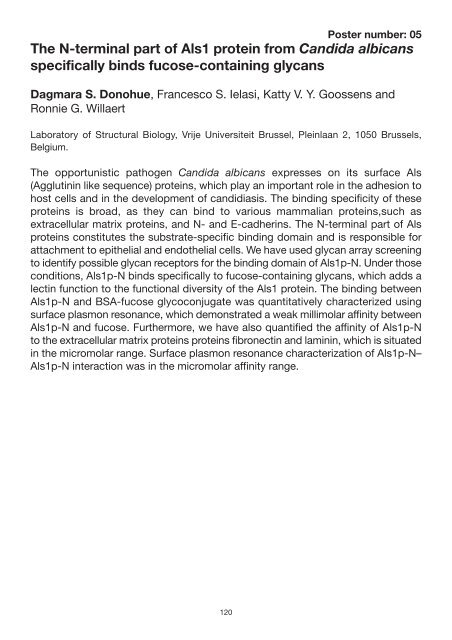Candida Infection Biology – fungal armoury, battlefields ... - FINSysB
Candida Infection Biology – fungal armoury, battlefields ... - FINSysB
Candida Infection Biology – fungal armoury, battlefields ... - FINSysB
Create successful ePaper yourself
Turn your PDF publications into a flip-book with our unique Google optimized e-Paper software.
Poster number: 05<br />
The N-terminal part of Als1 protein from <strong>Candida</strong> albicans<br />
specifically binds fucose-containing glycans<br />
Dagmara S. Donohue, Francesco S. Ielasi, Katty V. Y. Goossens and<br />
Ronnie G. Willaert<br />
Laboratory of Structural <strong>Biology</strong>, Vrije Universiteit Brussel, Pleinlaan 2, 1050 Brussels,<br />
Belgium.<br />
The opportunistic pathogen <strong>Candida</strong> albicans expresses on its surface Als<br />
(Agglutinin like sequence) proteins, which play an important role in the adhesion to<br />
host cells and in the development of candidiasis. The binding specificity of these<br />
proteins is broad, as they can bind to various mammalian proteins,such as<br />
extracellular matrix proteins, and N- and E-cadherins. The N-terminal part of Als<br />
proteins constitutes the substrate-specific binding domain and is responsible for<br />
attachment to epithelial and endothelial cells. We have used glycan array screening<br />
to identify possible glycan receptors for the binding domain of Als1p-N. Under those<br />
conditions, Als1p-N binds specifically to fucose-containing glycans, which adds a<br />
lectin function to the functional diversity of the Als1 protein. The binding between<br />
Als1p-N and BSA-fucose glycoconjugate was quantitatively characterized using<br />
surface plasmon resonance, which demonstrated a weak millimolar affinity between<br />
Als1p-N and fucose. Furthermore, we have also quantified the affinity of Als1p-N<br />
to the extracellular matrix proteins proteins fibronectin and laminin, which is situated<br />
in the micromolar range. Surface plasmon resonance characterization of Als1p-N–<br />
Als1p-N interaction was in the micromolar affinity range.<br />
120


